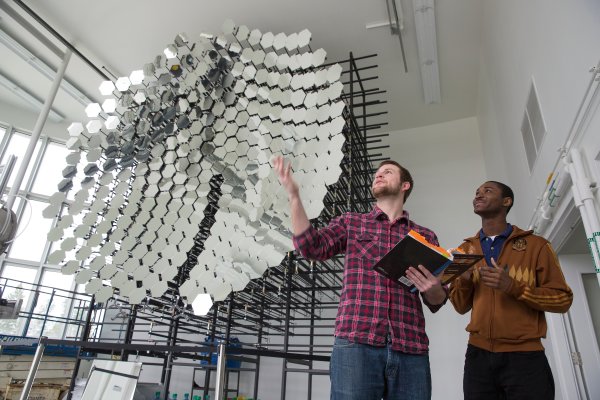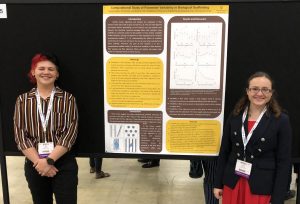Research Opportunities
Students research engineering questions and make new discoveries.
A significant component of studying at Valparaiso University’s College of Engineering is the collaboration with knowledgeable faculty. Students have the opportunity to be mentored by and work along side renowned experts on research. Students can participate in undergraduate research during the academic year for credit or during the summer as a paid internship through sponsored grants. This research can also be presented at the University’s Undergraduate Research Celebration and, often, at professional conferences.
Civil Engineering
Faculty: Carmine Polito, Ph.D.
Research Projects
Effects of frequency of load application in cyclic direct simple shear tests
Students Working on this Research
Andy Zhang
What do you enjoy most about working with students on undergraduate research?
It’s a special form of teaching involving a subject that I am passionate about.
Environmental Engineering
Faculty: Zuhdi Aljobeh, Ph.D.
Research Projects
Water Quality Modeling, Innovative Environmental Site Investigation Techniques, Stormwater Best Management Practices
Summer research was conducted working on working on developing water quality models for Big Cedar Lake and Little Cedar Lake located in Barry County in Michigan. As part of this undergraduate research, the students collected water quality data including water temperature, pH, dissolved oxygen concentrations, ammonium ion concentrations, chloride concentrations, and turbidity from a total of 68 water columns at different depths. In addition to establishing base-line (current) water quality of the two lakes, data was collected data develop water quality computer models for the two lakes. The models can be used to simulate/predict future water quality of the lakes for different climate change scenarios. Such predictions can be used by different stakeholders (e.g. engineers, watershed managers, planners, private citizens, and government agencies, etc.) to guide their decision making process.
Students Working on this Research
Kylie Krawulski and Mariela Gonzalez
What do you enjoy most about working with students on undergraduate research?
Working on research with undergraduate students enhances their learning experience.
Faculty: Dan White, Ph.D.
Research Projects
Hydrogen Line Radio Astronomy. Developing low-cost antennas, radio hardware, and software to “view” celestial objects by measuring their hydrogen content.
Small satellite mission development. Design the mission concept and satellite hardware for VU’s first satellite. Build engineering desktop models for demonstration and training new students and learn about the diverse skills needed to get working hardware launched into space.
Students Working on this Research
Hydrogen Line Radio Astronomy–Laura Floyd
Small Satellite Mission Development–Blair Bram, Ben Jones, Kailey White
What do you enjoy most about working with students on undergraduate research?
When students are interested and curious about their project, I get to help by reducing roadblocks to their progress instead of mapping out all of their activities like a typical class experience.
“You mean it’s possible for us to do this?” Seeing students embrace that they can actually be the “they” that does an awesome project of the caliber that they’ve only read about. The lots of work needed to make it happen is part of taking an idea and making it reality.
Mechanical Engineering
Faculty: Pete Johnson, Ph.D.
Research Projects
Guitar Soundboard Research: For this research, the objective is to develop and use a test stand to measure the vibration characteristics of a guitar soundboard. The data collected will be used to develop a model of the soundboard which will direct efforts to improve the sound quality of a guitar, likely through modifying the shape of structural supporting members on the back of the soundboard.
Engine Test Cell: For this research, the objective is to continue to develop the data acquisition system used to measure data from the engine test cell. The current system has the equipment to measure fuel flow rate, intercooler flow rate, and cooling system flow rates, but the software is not accurately processing the available signals.
Students Working on this Research
Guitar Soundboard Research: Lydia Burkee, Fiona O’Doherty
Engine Test Cell: Ian Jaegers, Kay Shoolian
What do you enjoy most about working with students on undergraduate research?
I enjoy working with students on a project that we can combine our efforts to both teach/learn and advance the goals of a project together. We learn together on many aspects of these projects since they are open-ended with no obvious solution.
Faculty: Luke Venstrom, Ph.D.
Research Projects
The U.S. Department of Energy has awarded Carbon Solutions, LLC a two-year grant to develop new support tools in the fight against climate change, and engineering students and faculty at Valparaiso University have been selected to help. Using the knowledge and experience gained through working with the James S. Markiewicz Solar Energy Research Facility, Valpo researchers will uncover ways to improve direct air capture (DAC) units — which pull CO2 from the atmosphere for storage elsewhere — utilizing solar power. “It is about as direct a project addressing climate change as you can get,” said Luke Venstrom, ’07, Ph.D., associate professor of mechanical engineering and Paul H. Brandt professor of engineering. “It’s about solving the problem that is the carbon dioxide already in the atmosphere.”
Valparaiso University was selected by Carbon Solutions, LLC. through project manager and Valpo alumnus Jonathan Ogland-Hand ’14, Ph.D., director of energy systems analysis.
“Valpo has a lot of expertise in solar energy research. I thought it would be a great partnership,” Ogland-Hand says. “The whole purpose of these machines is to take CO2 out of the atmosphere, so if you emit CO2 to get that energy, you’re defeating the purpose. You need a carbon-neutral source of energy, and the sun is one of those.”
Students will work to create system models that incorporate solar energy into the CO2 capture system, investigating how geothermal brine (salty water pumped up from the ground and into the DAC units) must be heated in-transit. In addition to finding ways to add this heat, student researchers will study materials and mechanisms best suited to working with the brine.
Carbon Solutions, LLC. will utilize these findings in software tools that will help businesses identify the best locations for DAC units in their region, as well as how best to store the captured carbon.
Students Working on this Research
Mario Ramos
What do you enjoy most about working with students on undergraduate research?
I love exposing students to the cutting-edge of the field and showing them how what they are learning about in class can be used to help solve the energy and climate crises. I also love when students become so engaged in a project that they develop their own independent ideas about the research.
Bioengineering
Faculty: Bethany Luke, Ph.D.
Research Projects
Computational scaffold research: biological scaffolds loaded with cells hold promise as treatments for ligament and tendon tears. However, few computational tools exist to help researchers design scaffolds, leading to time-consuming laboratory studies. To speed the design process and study the underlying principles of tissue production on scaffolds, we are developing computer models of the interactions between cells, scaffolds, and the surrounding environment.
Biomechanics – injury prevention: in this research, we use biomechanical analysis to determine how foot position affects knee stresses during squatting exercises. To predict these stresses, we use ground reaction force data and motion capture technology along with analytical tools from musculoskeletal biomechanics and tissue biomechanics.
Students Working on this Research
Computational research: Lauren Kadlec. Biomechanics: no active students.
What do you enjoy most about working with students on undergraduate research?
My favorite thing about research is working with students as they wrestle to find the solution to a problem that hasn’t been solved before (or sometimes even trying to define a problem). This process stretches students, helps them build technical skills, and helps build their confidence as engineers.
The Leitha and Willard Richardson Undergraduate Research Scholarship provides $500 to four undergraduate Engineering students annually to become involved in research in their area of interests from the start of their academic career until they graduate from Valparaiso University. The main motivation behind this scholarship is to encourage students to be involved with research in parallel with their academic work. Many studies show students who are involved with research are academically very successful since they can correlate the classroom topics to the real-world projects. These students more likely to pursue advanced or terminal degrees in their field of interest. Click here to apply for the scholarship.

